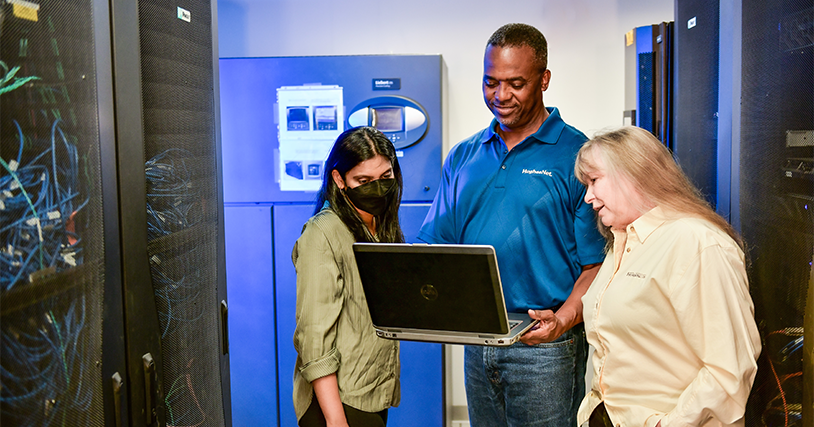
When it comes to meeting the networking needs of our enterprise customers, we at Hughes partner closely with our customers’ Information Technology (IT) teams, aiming to understand their pain points and challenges so we can design and deliver the solutions that help them achieve business goals. But we’re not just a managed services provider – we’re also a distributed enterprise like many of our customers, with a global employee base working across myriad offices, including company-owned, leased, home-based, customer-based and even highly secure government SCIFs. To help understand the challenges facing enterprise IT teams, our own IT team offers insight and answers questions to help inform our solutions and our roadmap.
As we plan for 2023, I sat down with our senior IT leaders to discuss recent challenges they’ve encountered as well as opportunities on the horizon as the digital transformation of the workplace continues to unfold. Here are four areas they identified:
- Managing the growing number of end user devices on the corporate network. Without hesitation, they agreed that the significant increase in the number of end user devices, including smartphones and tablets, on the corporate network is an area of concern. Further, the devices are not all company-owned, which creates additional complications for managing and securing them. Our IT team, like many of our customers’, is now required to manage user and application access for these additional devices on the network across a variety of operating systems. Plus, they have to clean off company data when the devices are no longer authorized.
When asked how they plan to address this challenge in the new year, our IT leaders noted that simple Virtual Private Networking (VPN) is no longer sufficient for access control in an environment with numerous devices. However, Zero Trust Network Access (ZTNA), where permission is granted based on the user, the device, and the geographical location, is a viable solution. Another area of opportunity is biometric identification in which fingerprint and facial recognition technologies offer two-factor authentication – an increasingly more common feature of the new generation of devices.
-
Proactive monitoring and resolution of issues. The IT team here strives to be as proactive as they can in supporting company technology, and to that end, detecting issues before they become a problem for the user is a priority. Our hardware manager gave the example of monitoring laptop batteries: it is possible to monitor and replace batteries before a user raises a flag that their computer won’t hold a charge. Contacting the user and updating the battery in advance, can prevent a negative experience, not to mention a dip in productivity.
Detecting application problems is another area where being proactive makes a difference. For all devices and systems, there is a universal need to manage updates and patches. The challenge involves managing users who want the latest update and patches alongside those who rarely check for updates and do not want to be disrupted by the process. The IT leadership team is reviewing a self-service option for updates, comparing that to an automated option where the device is triggered to update regularly. Self-service requires the user to be proactive, whereas the auto-trigger can cause updates and reboots at inopportune times (e.g., during a Zoom call or Microsoft Teams meeting). -
Transitioning to the cloud. Our conversation also covered the delivery of core services and the migration to the cloud. Transitioning third-party applications such as Office365 and Salesforce is straightforward. Our IT team integrated access to these cloud applications with our single sign-on solution. However, the migration of proprietary applications presents some challenges as developers did not write legacy apps to run in the cloud; like many of our customers, our IT organization is working with the developers of these legacy system to update or containerize and move them into the cloud.
-
Data analysis and visualization. Data access is one step in achieving a digital workplace but the ability to bring multiple data sets together for analysis brings it to a whole other level. Our IT team, like many of our customers’, is looking at artificial intelligence and machine learning (AI/ML) to enhance the access to, and the usefulness of, the information gathered. To help facilitate the implementation of AI/ML for data analysis, our IT team is using the Google enterprise data warehouse called BigQuery. Along with this centralized data warehouse there is also a need for governance and data usage reviews. As we share our learnings with customers, we are seeing a migration toward a Modern Data Analytics Platform (MDAP), which provides a set of tools and structure for processing, analyzing and presenting information in a way that is useful to the business.
The transformation to a digital workplace – while not without growing pains – is inspiring when you consider the possibilities for the connected user experience and enhanced productivity. Hughes is working alongside our customer IT leaders to smooth the transition for organizations in their quest to become a truly digital workplace. Together, we are advancing toward that Star Trek experience where touch screens and voice interactions will be commonplace: “Hey Siri, please show me the sales performance data compared to marketing expenditures for the second quarter.”